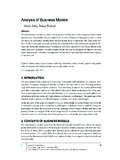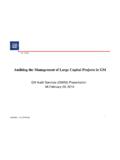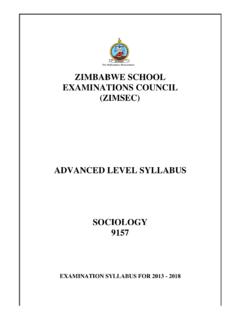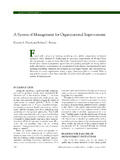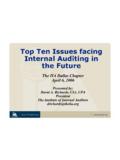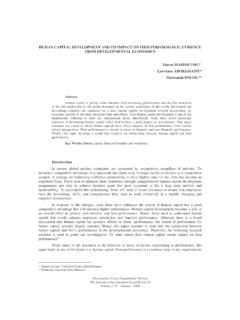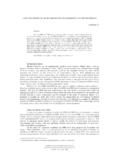Transcription of 1. - Supply Chain Risk Leadership Council
1 1 2 1. Executive Summary: The Need for Supply - Chain Risk management Modern enterprises increasingly find themselves relying on others for their success. Historically, enterprises have spent less than a third of their budgets on purchased goods and services, having relied on internal sources for these. Today, many enterprises spend most of their budget on purchased goods and services. This is in large part because of the advantages enterprises have found in strategies such as globalization, outsourcing, Supply -base rationalization, just-in-time deliveries, and lean inventories.
2 In addition, many companies have consolidated operations both internally and externally to achieve economies of scale. While globalization, extended Supply chains, and supplier consolidation offer many benefits in efficiency and effectiveness, they can also make Supply chains more brittle and can increase risks of Supply - Chain disruption. Historic and recent events have proven the need to identify and mitigate such risks . The March 2011 Tohoku earthquake and subsequent tsunami in Japan showed how one event can disrupt many elements of global Supply chains, including Supply , distribution, and communications (Lee and Pierson, 2011).
3 In extreme cases, a single event at one location can severely damage an enterprise or even cause it to leave an industry. Effective Supply - Chain risk management (SCRM) is essential to a successful business. It is also a competence and capability many enterprises have yet to develop. In some areas, both problems and practices are well defined. In others, problems are defined, but practices are developing. In still other areas, both the definition of the problems and the practices needed to address them are developing. In sum, SCRM is an evolving field.
4 In this document, the Supply Chain Risk Leadership Council (SCRLC), a cross-industry Council including Supply - Chain organizations from more than two dozen world-class manufacturing and services firms and academic institutions, outlines an approach to SCRM. This document provides a framework for collecting, developing, and implementing best practices for SCRM. It focuses on Identifying internal and external environments Risk identification and assessment Risk treatment Continual monitoring and review of risks and their treatment.
5 This document is meant to be a practitioner s guide to SCRM and associated processes. Approaches for identifying, evaluating, treating, and monitoring Supply Chain risk will differ across individual enterprises depending on their industry, the nature of their extended Supply chains, and their tolerance for risk (or risk appetite). Therefore, rather than prescribing a specific approach to SCRM, this document notes some guidelines and possible approaches an organization may wish to consider, including examples of tools other organizations have used.
6 Specific enterprises will adapt the concepts included in this document to fit their unique characteristics and expand the depth and breadth of the processes to meet the requirements of their organizations. This document excludes risks such as those to brand reputation or intellectual property which exist outside the Supply Chain . It seeks to foster the development of best SCRM practices for application in industrial settings rather than provide a regulatory framework. 3 This is a working document. Its contents reflect a collection of best-practice inputs from SCRLC members.
7 The inputs on Supply - Chain risk management are, to our knowledge, unique, though based in part on previous works regarding Supply - Chain risk more generally. The problems of SCRM and the means to address them will continue to change. As they change, we hope to both update this document and to issue additional publications detailing evolving areas. This document serves as a baseline for both helping enterprises assess and address Supply - Chain risks and for documenting evolving practices. We seek collaboration to promote these practices for Supply - Chain resiliency.
8 About the SCRLC The SCRLC ( ) is a cross-industry organization including world-class manufacturing and services Supply - Chain organizations and academic institutions that work together to develop and share best practices in Supply - Chain risk management . Its mission is to create Supply - Chain risk management standards, processes, capabilities, and metrics that reflect current best practices and can be widely adopted. 4 2. SCRM: An Overview The SCRLC defines Supply - Chain risk as the likelihood and consequence of events at any point in the end-to-end Supply Chain , from sources of raw materials to end use of customers, and Supply - Chain risk management as the coordination of activities to direct and control an enterprise s end-to-end Supply Chain with regard to Supply - Chain risks .
9 Supply - Chain risk management integrates several previous or ongoing initiatives, including those for business continuity and Supply - Chain security. Supply - Chain security- management systems seek to resist intentional, unauthorized act(s) designed to cause harm or damage to, or by, the Supply Chain (ISO 28000:2007). SCRM goes beyond this by not only seeking to address such acts but also to promote business continuity and to mitigate any disruptions, that is, events that interrupt normal business, activities, operations, or processes (ASIS International, 2007; ASIS International and BSI, 2010).
10 Such events may not only be intentional acts such as sabotage but also unintentional acts such as a hurricane. They may be both events anticipated, such as political unrest, or unanticipated, such as an earthquake. Risk management Process Overview In this document, we provide an approach to risk management . Our process, based on ISO 31000, covers elements of risk identification, risk assessment, and risk treatment (Figure ). ISO 31000 is a key building block to our approach; while adapting it to our own purposes, we recognize the need to avoid replicating standards documents but rather to strive for practices that cover security, crisis, continuity, and recovery requirements enterprises may have.


